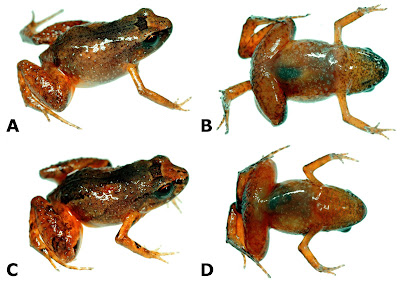 |
| Noblella peruviana (Noble, 1921) in von May, Diaz, Ttito, Santa-Cruz & Catenazzi, 2024. |
Abstract
We revise the taxonomy of the frog genus Noblella on the basis of a molecular phylogeny. Previous studies recognized that Noblella is non-monophyletic, with one clade distributed from southeastern Peru to northeastern Bolivia and adjacent areas in Brazil and another clade distributed from northern Peru to Ecuador and southeastern Colombia. The lack of sequences from the type species Noblella peruviana prevented the investigation of its phylogenetic position and the status of related taxa. Our rediscovery after more than 115 years allowed for the inclusion of DNA sequences of Noblella peruviana obtained from specimens collected at the type locality in southeastern Peru. We inferred a phylogeny based on a concatenated dataset (three mitochondrial and two nuclear loci) using Bayesian and maximum likelihood methods. Our phylogeny corroborated the non-monophyly of Noblella and helped resolve the status of related taxa, including Psychrophrynella bagrecito, the type species of the genus Psychrophrynella (rediscovered after 42 years). We identified a clade containing N. peruviana, P. bagrecito, and other species of Noblella and Psychrophrynella distributed in southern Peru. Given that the name Noblella predates Psychrophrynella, we propose that Psychrophrynella should be considered a junior synonym of Noblella. The second clade contains species of Noblella distributed in Ecuador and northern Peru, including N. myrmecoides, which used to be the type species of the genus Phyllonastes. Consequently, we propose to reinstate the genus Phyllonastes to accommodate all species of Noblella distributed in Ecuador, northern Peru, southeastern Colombia, and adjacent areas in Brazil. We present an updated taxonomy including new combinations for 12 species and reinstatements for three species.
Keywords: amphibians; Andes; terrestrial-breeding frogs
Noblella Barbour
Noblella Barbour, 1930: 81.
Type species Sminthillus peruvianus Noble, 1921: 1, by original designation.
Phyllonastes Heyer, 1977: 151.
Type species Euparkella myrmecoides Mynch, 1976, by original designation.
Content: Twelve species currently recognized in the genus (this paper):
N. bagrecito, N. carrascoicola, N. chirihampatu, N. glauca,
N. losamigos, N. madreselva, N. peruviana, N. pygmaea,
N. ritarasquinae, N. thiuni, N. usurpator, and N. vilcabambensis.
(Note: No sequences available for N. carrascoicola and N. ritarasquinae. Proposed inclusion in the genus is based on similarities in morphology and geographic distribution.)
 |
| Noblella peruviana, adult specimens collected at the type locality (A–D) Snout-vent length (SVL) is given in mm. (A, B) female (CORBIDI 17510, SVL = 17.8 mm); (C, D) male (MUBI 19037, SVL = 13.3 mm) |
Rudolf von May, M. Isabel Diaz, Alex Ttito, Roy Santa-Cruz and Alessandro Catenazzi. 2024. The Rediscovery of Noblella peruviana after More than 115 Years helps Resolve the Molecular Phylogeny and Taxonomy of Noblella (Amphibia, Anura, Strabomantidae). Diversity. 16(10), 613. DOI: doi.org/10.3390/d16100613
